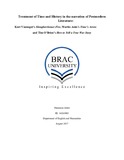| dc.contributor.advisor | Islam, Dr. Syed Manzoorul | |
| dc.contributor.author | Akter, Shammee | |
| dc.date.accessioned | 2018-01-15T04:26:22Z | |
| dc.date.available | 2018-01-15T04:26:22Z | |
| dc.date.copyright | 2017 | |
| dc.date.issued | 2017-08 | |
| dc.identifier.other | ID 14263003 | |
| dc.identifier.uri | http://hdl.handle.net/10361/9051 | |
| dc.description | This thesis is submitted in partial fulfillment of the requirements for the degree of Masters of Arts in English, 2017. | en_US |
| dc.description | Cataloged from PDF version of thesis. | |
| dc.description | Includes bibliographical references (pages 38-39). | |
| dc.description.abstract | Postmodernism is considered as one of the broad terms in contemporary cultural domain. Literature is perhaps the most familiar aspect where postmodernism can be understood. The issue of time and history is a vital aspect in any literature. This paper has attempted to discuss postmodernism and the treatment of time and history in three postmodern literary works. The selected literary texts are Kurt Vonnegut’s Slaughterhouse-Five (1969), Martin Amis’s Time’s Arrow (1991) and Tim O’Brien’s How to Tell a True War Story (1990). | en_US |
| dc.description.statementofresponsibility | Shammee Akter | |
| dc.format.extent | 40 pages | |
| dc.language.iso | en | en_US |
| dc.publisher | BRAC University | en_US |
| dc.rights | BRAC University thesis are protected by copyright. They may be viewed from this source for any purpose, but reproduction or distribution in any format is prohibited without written permission. | |
| dc.subject | Postmodernism | en_US |
| dc.subject | Slaughterhouse-five | en_US |
| dc.subject | Time’s arrow | en_US |
| dc.subject | How to tell a true war story | en_US |
| dc.title | Treatment of time and history in the narration of postmodern literature: Kurt Vonnegut’s slaughterhouse- five, Martin Amis’s time’s arrow and Tim O’Brien’s how to tell a true war story | en_US |
| dc.type | Thesis | en_US |
| dc.contributor.department | Department of English and Humanities, BRAC University | |
| dc.description.degree | M.A. in English | |

